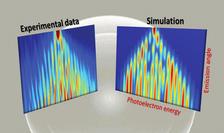The central photo line is split in a multitude of lines - the so-called sidebands (experimental data on the left). In the quantum mechanical picture, the appearance of these sidebands is the result of the interference between electron waves emitted at different periods of the optical laser pulse.
The behavior of atoms in strong electromagnetic fields shows often surprisingly complex results. A recent measurement at FLASH carried out by DESY scientists in collaboration with the Max Born Institute and the European XFEL as well as scientists from the Lund University and Universities San Sebastian and Moscow presents such complex effects. The angularly resolved photoelectron measurements show strong modulations indicating interference of electrons with high angular momenta in a multi-photon interaction.
Experiments like this are an ideal test bed to investigate how well the interaction of strong fields with atoms is understood theoretically and how reliable it can be calculated. The performed simulations show a good agreement with the measurements indicating that the observed multi-photon process can be described quite well by current models.
In detail, the angular distribution of photoelectrons from a Ne gas target ionized by extreme ultraviolet (XUV) free-electron laser radiation from FLASH in the presence of an intense near infrared (NIR) dressing field was recorded. The highly nonlinear interaction with absorption and emission of more than 10 NIR photons results in the formation of numerous sidebands.
Photoelectrons emitted during the presence of a strong NIR field can be shifted in energy by an integer number of optical quanta NIR. The central photo line is split in a multitude of lines - the so-called sidebands. In the quantum mechanical picture on the other hand, the appearance of sidebands is the result of the interference between electron waves emitted at different periods of the optical laser pulse.
In the presented experiments the amplitude of the sidebands varies strongly with the emission angle and the angular distribution pattern reveals clear signatures of interferences between the different angular momenta for the outgoing electron in the multi-photon process. The large number of absorbed NIR photons adds more and more angular momentum to the emitted electrons – much higher angular momenta than present in the atom without NIR field. These high angular momenta give rise to complex angular distributions leading to the strong modulation.
While theoretical and experimental studies have so far considered such modulations only for extremely short – only few fs long - XUV pulses, in the presented experiment the measured oscillatory structure is still present for ten times longer (~ 80 fs) XUV pulses. Even averaging over a large range of NIR intensities these structures are still present and thus demonstrate the universal character of such interference effects.
(from authors)
Interference in the angular distribution of photoelectrons in superimposed XUV and optical laser fields, S. Düsterer, L. Rading, P. Johnsson, A. Rouz´ee, A. Hundertmark, M. J. J. Vrakking, P. Radcliffe, M. Meyer, A. K. Kazansky and N. M. Kabachnik, J. Phys. B: At. Mol. Opt. Phys. 46 (2013) 164026 (6pp).







